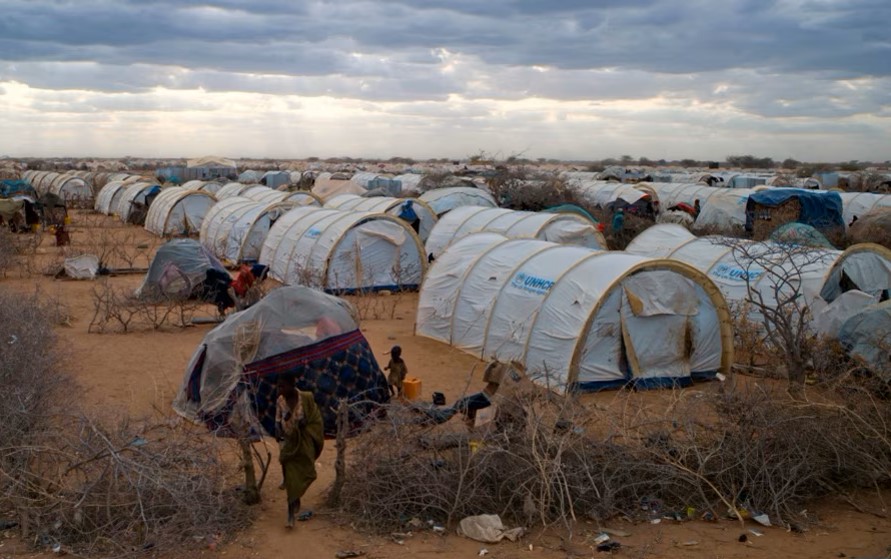
Climate change-induced displacement in Eastern Africa has led individuals to cross international borders, seeking refuge in Kenya from neighboring countries. This population faces profound challenges, including the loss of vital assets such as crops and livestock, which constitute their primary sources of livelihood. This vulnerability exposes them to challenges or risks as they endeavor to resettle and reconstruct their lives. With Eastern Africa experiencing frequent climate-related disasters, the issues of displacement and livelihood disruption have become persistent across countries within the region, including Kenya.
This policy brief evaluates the impact of the 2021 amendments to the Kenya Refugee Act and the 2023 Shirika Plan. While these updates represent significant progress, they currently lack a specific framework to manage refugees in Kenya who are displaced by climate-related disasters. It further explores pressing needs specific to refugees displaced by climate-related disasters not explicitly addressed within the Refugee Act. It underscores challenges stemming from inadequate data to differentiate between environmental refugees and those displaced by other causes. It further seeks to explore the correlation between the increased influx of refugees and regional challenges, particularly regarding the depletion of resources essential for populations experiencing significant livelihood losses.
Recommendations made include the need to incorporate refugees displaced as a result of climate change into legal frameworks, ensure that surveillance systems can distinguish between refugees displaced by climate change and other drivers, and promote sustainable livelihoods to address resource overstretching and depletion, intended to mitigate tension between the host community and the refugee community especially in Turkana and Garissa counties.
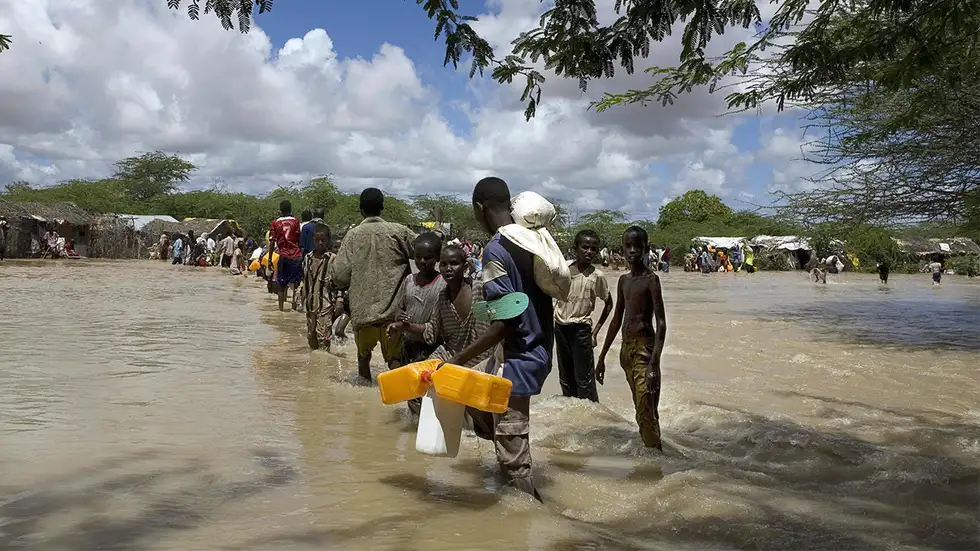
Introduction
Kenya hosts some of the world’s largest refugee populations and accommodates some of the most extensive refugee camps globally. Dadaab and Kakuma refugee camps are situated in the isolated and food-insecure areas of Northern Kenya. Refugees and asylum seekers are displaced due to persecution, violence, disasters, and the impact of climate change. By the end of December 2023, there were approximately 714,137 registered refugees and asylum seekers in the country.[1] While Kenya has made strides in ensuring refugees are catered to, through favorable policies, the vast majority of ensuring their needs are met is done by international organizations. Kenya adopted the Comprehensive Refugee Response Framework (CRRF) in 2020 to create a more sustainable approach to supporting refugees. This framework aims to empower refugees towards self-reliance, address the needs of Kenyan host communities, and align with global refugee protection goals such as to alleviate host country burdens, empower refugee self-sufficiency, broaden access to resettlement options and foster safe and dignified conditions for return to countries of origin (UN, 2016). It also extends beyond addressing the displacement of refugees to encompass the host community, focusing on climate change mitigation and ensuring sustainable livelihoods.[2]
The needs of refugees in Kenya are addressed through the Refugee Act (2021), which establishes a comprehensive legal framework for their protection, management, and assistance. It acknowledges the Organization of African Unity (OAU) 1969 Convention governing the specific aspects of refugee problems in Africa, which addresses the granting of refuge to those displaced by natural disasters. The Act outlines the rights and obligations of refugees, including access to education, healthcare, and employment. It also establishes the Department of Refugee Services (DRS) to coordinate refugee matters and facilitate their integration into Kenyan society.
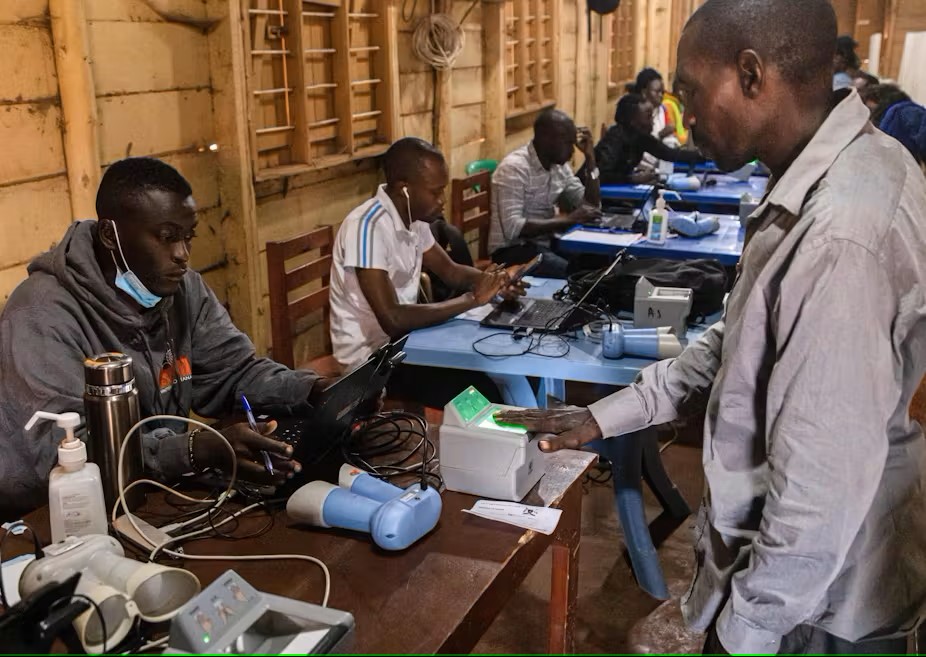
Additionally, the Act prohibits refoulement (the forced return of refugees to a country where they are likely to face heightened risk) and ensures that refugees are not discriminated against based on their nationality, race, or religion. Furthermore, the Shirika Plan, previously known as the Marshal Plan, developed in 2023 in collaboration with the United Nations High Commissioner for Refugees (UNHCR), focuses on the economic and social integration of refugees into the country. Despite these efforts, refugee management in Kenya remains a pressing issue, which is expected to persist given the deteriorating impacts of climate change globally. It is also important to note that there has not been a special emphasis on developing guidelines specific to refugees displaced by climate disasters. Such guidelines would greatly assist in the sustainable management of their resettlement or repatriation.
Background
Eastern Africa is particularly vulnerable to the implications of climate change, experiencing a high frequency of extreme weather events and environmental degradation.[3] Severe droughts desiccate the landscape, resulting in crop failure and exposing communities to food insecurity. This compels individuals to abandon their residences with scant provisions, embarking on a desperate quest for water and sustenance.[4] Floods, on the other hand, unleash torrents that submerge entire villages, destroying homes and livelihoods. Families are separated, and the risk of waterborne diseases skyrockets, pushing survivors into overcrowded camps with little hope for an economic future.[5]
Despite the challenging climate and environmental issues, several key partnerships, initiatives, and promising practices have produced positive outcomes in the region. IGAD has been a leading voice in regional climate discussions and declarations, actively involved in managing the complex transboundary challenges posed by climate change and climate-induced migration.
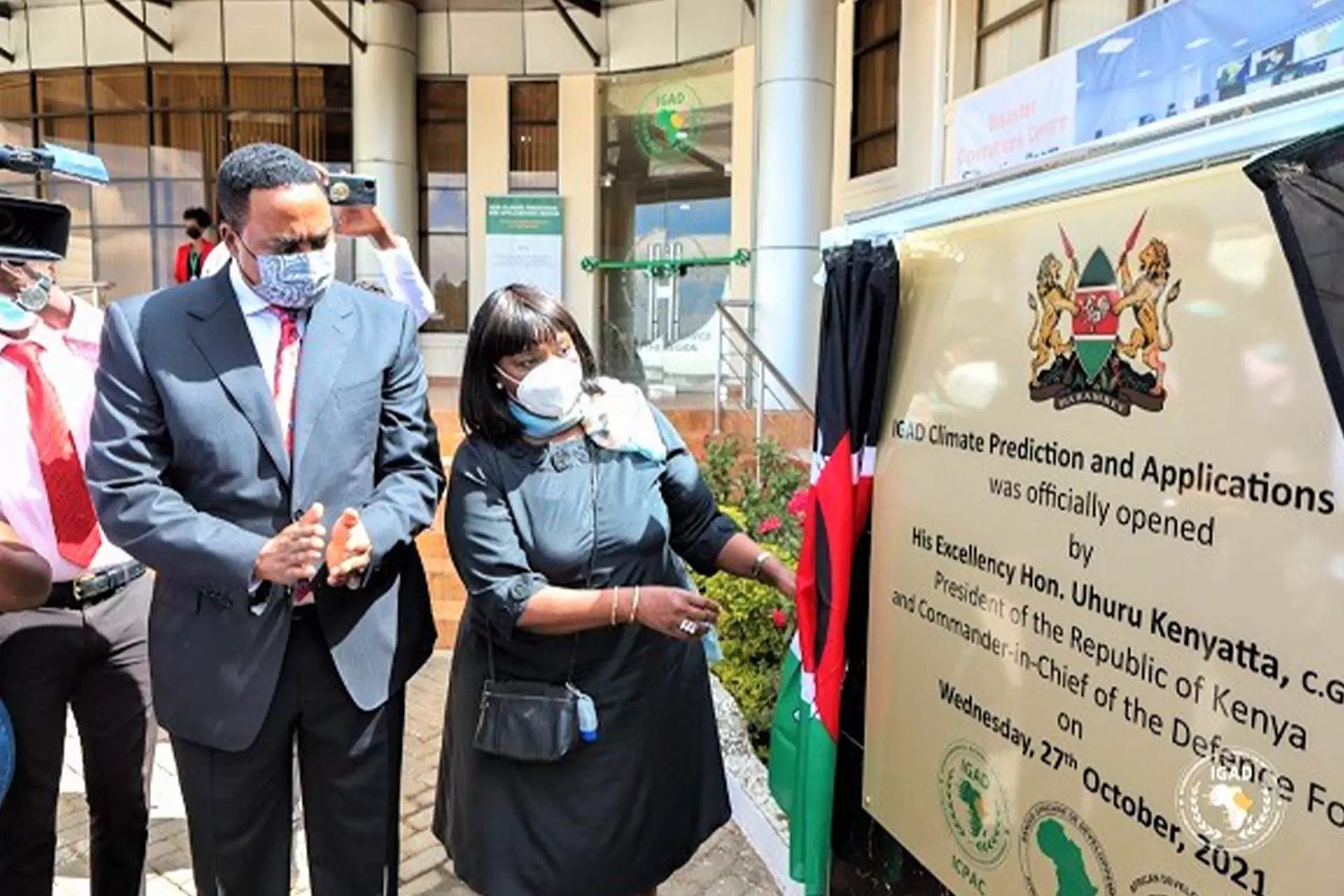
In 2021, IGAD established the IGAD Center of Excellence for Climate Adaptation and Environmental Protection (IGAD CAEP),[6] and a Regional Adaptation Strategy that complements existing climate-related strategies and action plans, ensuring enhanced resilience capacity and resources for climate change adaptation.[7] In Eastern Africa, the East African Community Climate Change Policy (EACCCP) emphasizes the importance of formulating measures for disaster risk management to effectively address environmental displacement.[8] The EACCCP lacks a specific plan for climate disaster displacement, but it lays the groundwork for future action. The EACCCP policy prioritizes adaptation strategies to help communities cope with climate change impacts, potentially reducing displacement in the long run. It also recognizes the vulnerability of populations reliant on agriculture and ecosystems, indirectly acknowledging their displacement risks.
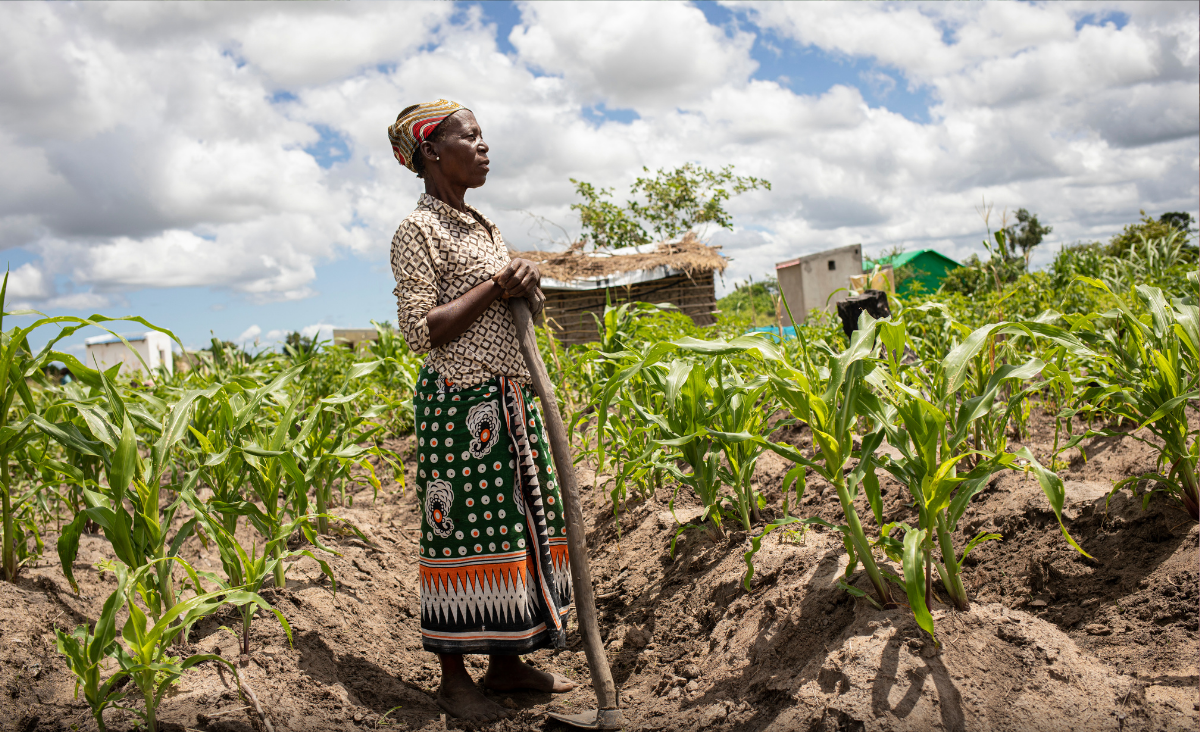
Kenya has faced similar challenges of climate change and displacement as addressed earlier, leading to the internal displacement of many of its citizens and the entrance of refugees from the region into Kenya. Despite this, owing to its accommodating refugee policies and the consistent presence of humanitarian aid from organizations such as the Red Cross and UNHCR, Kenya is widely regarded as a beacon of relative stability in the region.[9] It has progressively become a destination of choice for individuals seeking refuge from climate-related disasters in neighboring countries.[10] The increased number of refugees displaced as a result of not only climate disasters adds to the challenges the country faces from its own climate-related issues. Climate change not only displaces people but also disrupts pastoral lifestyles leading to a permanent loss of income. As climate change intensifies its grip, the number of refugees displaced as a result of its effects is expected to surge.[11] This introduces another layer of challenges, including the complex relationship between climate change and displacement. Displacement often occurs in areas most likely to have weak governance and institutions, as well as high levels of social and economic inequality, leaving them ill-equipped to deal with the impacts of climate change. Such circumstances can create or exacerbate community tensions and fragility, with the potential to escalate into conflict.[12]
Methodology
This paper employs a qualitative research approach, starting with a comprehensive desk review of existing literature, followed by in-depth interviews. The desk review served as the foundation for identifying gaps in current research. From this review, an open-ended interview guide was developed to address these gaps. Respondents were selected from a pool of experts and policymakers with substantial knowledge of displacement and the impacts of climate change within Kenya and the broader eastern Africa region. The interview data were analyzed thematically by identifying and coding patterns, providing a comprehensive understanding of the key issues and insights from the respondents.
Key Findings
The following issues remain pertinent in addressing refugees in Kenya displaced from the region due to climate-related disasters. These aspects are essential for assessing different areas to enhance Kenya’s management of refugees.
Gaps on National Policies on Refugees Displaced as a Result of Climate Disasters
In Kenya, the DRS, established after the 2021 amendment of the Refugee Act, oversees refugee status determination and is responsible for refugee management in Kenya, including reception, registration, and issuance of documentation.[13] The Act provides the legal framework for the protection and management of refugees in Kenya.[14] It outlines the rights and obligations of refugees, as well as the responsibilities of the government and other stakeholders in their protection and assistance.[15] The Act, while adhering to international conventions, does not explicitly mention refugees displaced as a result of climate disasters from the region despite the cyclical nature of climate disasters and displacement in the region.This leaves people displaced by climate shocks in a perpetuated and precarious situation, without guaranteed access to assistance, repatriation, or resettlement. Their plight remains largely unrecognized within the legal framework, adding another layer of hardship to their already immense challenges, including a lack of livelihood.
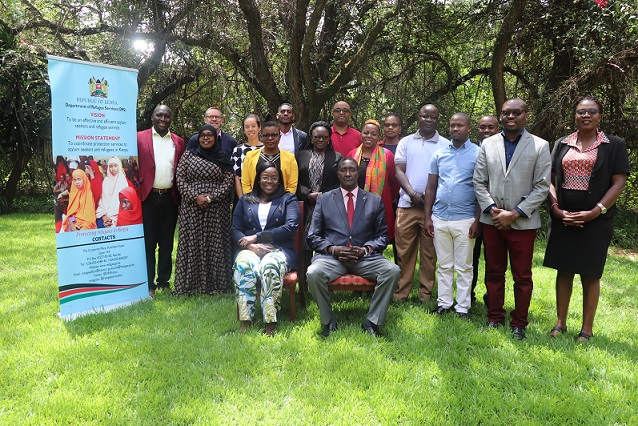
In June 2023, Kenya advanced towards urbanizing the Kakuma and Dadaab refugee camps in response to their overcapacity and overstretched resources through the Shirika Plan.[16] This initiative intended to reform the existing system by creating a comprehensive database of refugee numbers, identities, sources, and status, along with their economic activities.[17] Kenya is transitioning from a restrictive approach to refugee movement, which confined them mainly to camps, to one that promotes their social and economic integration. While the Shirika Plan aims to promote the inclusive social and economic integration of refugees, the task of acquiring a sustainable income in Kenya remains a formidable challenge for them. The Employment Act 2019 grants the right to work in Kenya to all legal residents, while the Refugees Act of 2021 specifies that refugees also have this right but must obtain work permits. Refugees can apply for Class “M” work permits, which are free but have demanding documentation requirements. These permits also require attestation from a Kenyan employer, justifying the hiring of a refugee over a Kenyan national. Additionally, non-Kenyans cannot hold jobs that Kenyan citizens are capable of doing, making it even more complex for refugees to obtain a source of livelihood in their already economically fragile state.

It is also noteworthy to consider how the country addresses the impacts of climate change in its policies, particularly concerning forced migration and displacement. The Kenya National Adaptation Plan 2015-2030 primarily addresses displacement due to climate change in relation to internal displacement, with only a brief mention of refugees displaced into Kenya as environmental related factors. The plan lacks specific frameworks for the provision of resources, services, and long-term management solutions for this population.
Differentiating Climate-Induced Displacements from other Drivers
From an analysis of existing policies, it is evident that Kenya has made substantial progress in providing comprehensive social and economic support for refugees. However, the ongoing inflow of refugees into the Dadaab and Kakuma refugee camps from 2020 to 2023 (Figure 1) highlights the urgent need to assess the number of refugees in Kenya displaced by climate change related causes. Multiple reports highlight the growing displacement of communities due to climate-related disasters.[18] In the Horn of Africa, these disasters not only result in forced displacement but also drive migration as individuals lose their main sources of livelihood. This migration is often motivated by the need to access alternative livelihoods or humanitarian assistance.[19] This is evidenced by the fact that over 110,000 Somalis crossed the border into Kenya between 2022 and 2023, driven by the severe drought in the Horn of Africa, which was the most severe in 40 years.[20]

Figure1: Illustrates total number of individuals displaced from neighboring countries to Dadaab and Kakuma refugee camps in Kenya between 2020 to 2023.[21]
The majority of refugees and asylum-seekers in Kenya come from Somalia (54%) followed by South Sudan (24.5%), the Democratic Republic of Congo (DRC) (8.9%), and Ethiopia (5.8%). People of concern from other nationalities, including those from Burundi, Sudan, Uganda, Eritrea, Rwanda, and other countries, make up 6.7% of the total population, which stood at 501,049 as of the end of October 2020. Nearly half of the refugees in Kenya reside in Dadaab (44%), 40% in Kakuma, and 16% in urban areas, mainly Nairobi.[22] There are also 18,500 stateless persons in the country. It is imperative to acknowledge that the data concerning refugee displacement into the country, as shown, lacks explicit aggregation distinguishing between those displaced as a result of climate change related causes, persecution or conflict. In collaboration with NGOs like UNHCR and the Refugee Consortium of Kenya (RCK), the Kenya government has conducted data collection using border monitors to gather refugee demographic information. However, these efforts often struggle to comprehensively monitor entry reasons due to challenges in covering the vast and porous borders effectively. Accurate data is key to trigger a prompt response and crucial for gaining a comprehensive understanding of the issue’s scope and essential in designing targeted programs.

The relationship Between Resource Strain and Conflict
When examining climate change, it is crucial to consider its impact on strained resources, such as water and arable land. Reassessing hosting conditions, especially in regions like North Eastern Kenya, which face similar climatic disasters, is crucial. While refugee camps in these areas may be geographically convenient, their presence also heightens the vulnerability of both the host community and refugees, leading to increased strain on existing resources. This strain is particularly prone among populations reliant on pastoralism and farming as their primary source of income, often leading to heightened tension potentially leading to conflict, especially in regions with intense competition for these resources.[23] Climate change further exacerbates environmental stress by degrading natural resources, leading to increased socio-economic stress. This stress manifests as water and food insecurity, health issues, migration, economic decline, weakened institutions, reduced economic growth, and social erosion. These factors can create a vicious cycle of social instability and resource depletion often resulting in violent forms of conflict such as insurgencies, identity conflicts, or urban violence. These in turn can further escalate social disruption.[24]
Previous research has consistently identified economic well-being as the primary factor linked to the occurrence of conflict within Africa.[25] Evidence has shown that deteriorating climatic conditions as a result of climate change increases the probability of conflict as demonstrated in Figure 2. By the year 2030, according to the averaged findings of 18 climate models, there is projected to be a 54% rise in armed conflict occurrences within the region.[26]

Figure 2: Links between climate change, human insecurity and societal instability, Jürgen Scheffran (2009).
According to Kenya’s National Climate Change Response Strategy(KNCCRS), significant increases in climate migrants have the potential to generate conflicts, impact the safety and security of Kenya’s urban areas, and impede sustainable development.[27] The combination of prolonged drought and increased flooding in Eastern Africa is exacerbating land use conflicts in Kenya’s northern Rift Valley region, which could escalate further with the increased number of refugees seeking the same scarce resources. Ongoing tensions between herders and landowners have already led to more organized and violent attacks, heightening inter-communal tensions, with incidents of cattle theft and banditry on the rise.[28] Kenya has been proactive in addressing this issue through the Global Compact for Refugees, emphasizing refugee and host community self-reliance. Since devolution in Kenya, the CRRF have been localized effectively through programs developed at county level like Kalobeyei Socio Economic Development programme (KISEDP)[29] and Garissa Integrated Socio-Economic Programmes (GISEDP).[30] Supporting the self-sufficiency and resilience of this population can reduce their reliance on humanitarian assistance during disasters, leading to more sustainable responses to climate-induced displacement that benefit both refugees and host communities. These projects highlight the potential for integrating more sustainable solutions into the Shirika Plan.
Conclusion
Addressing challenges faced by refugees in Kenya displaced from the region as a result of climate-related disasters requires a multifaceted approach. The Refugee Act (2021) lays a foundation for refugee protection but lacks a specific framework to address the recurring risk factors faced by environmental refugees and provide sustainable solutions for their significant loss of livelihood, leaving them in a vulnerable situation. Despite potential solutions to timely problems addressed in the CRRF, there is a need to follow up on solid solutions with the development of roadmaps on how to achieve the objectives beyond emergency response. The Shirika Plan, although promising, is still in its early stages and requires further development, including integrating climate-specific frameworks. Accurate data on climate-induced displacement is essential for designing targeted programs and ensuring sustainable livelihoods for refugees. Furthermore, addressing the strain on resources as well as the potential for conflict and societal instability requires proactive measures, such as societal integration, promoting refugee self-reliance, and integrating economically sustainable solutions into existing frameworks. Overall, there is need for concerted efforts from the government, international organizations, and other stakeholders to effectively manage the challenges faced by environmental refugees in Kenya.

Recommendations
- The Ministry of Interior and Coordination of National Government to petition Parliament to amend the Refugee Act (2021) to explicitly include provisions for environmental refugees.
- The DRS, KNBS, and NGOs actively involved in tracking displacements, such as the UNHCR, should collaborate to enhance existing refugee surveillance systems.
- The Ministry of Energy and Petroleum, in collaboration with the Ministry of Environment, Climate Change, and Forestry, should partner with the county governments of Garissa and Turkana to promote the development of clean and renewable energy sources for refugees in both Dadaab and Kakuma camps.
Notes
[1] UNHCR (2024). Open Data Portal – KENYA Registered refugees and asylum-seekers as of 31 January 2024
[2] Government of Kenya (2020). Kenya’s Comprehensive Refugee Response Framework (CRRF)
[3] Haile, G. G., Tang, Q., Hosseini‐Moghari, S. M., Liu, X., Gebremicael, T. G., Leng, G., … & Yun, X. (2020). Projected impacts of climate change on drought patterns over East Africa. Earth’s Future, 8(7), e2020EF001502.
[4] Kogo, B. K., Kumar, L., & Koech, R. (2021). Climate change and variability in Kenya: a review of impacts on agriculture and food security. Environment, Development and Sustainability, 23, 23-43.
[5] Chowdhury, M. A., Hasan, M. K., Hasan, M. R., & Younos, T. B. (2020). Climate change impacts and adaptations on health of Internally Displaced People (IDP): An exploratory study on coastal areas of Bangladesh. Heliyon, 6(9).
[6] IGAD (2021). The IGAD Centre of Excellence for Climate Change Adaptation, and Environmental Protection
[7] IGAD (2023). The IGAD Climate Adaptation Strategy
[8] East African Community (2011). EAC Climate Change Policy Framework
[9] Central Intelligence Agency (2024). The World Factbook- Kenya
[10] Kyalo, M. (2021). Migration and Climate Change in the Horn of Africa:: Mainly in Kenya, Ethiopia, Sudan and South Sudan. DARE: Holy Trinity College Journal, (13), 278-288.
[11] Institute for Security Studies (2022). East Africa and the Horn light the way for climate migrants
[12] International Alert (2024). Climate crisis and natural resource management
[13] UNHCR Kenya (2021). Refugee Status Determination
[14] Refugees International (2023). How Implementing the New Regulations for the 2021 Refugee Act Can Improve the Lives of Refugees in Kenya
[15] Kenya Law (2021). Refugee Act, No. 10 of 2021
[16] UNHCR (2023). Government of Kenya’s Shirika Plan
[17] Refugees International (2023). Context News: Kenya’s Bold New Shirika Refugee Plan is Model for Future
[18] Oliver-Smith, A. (2016). “Climate Change and Population Displacement: Disasters and Diasporas in the Twenty-First Century,” in Anthropology and Climate Change, Routledge, pp. 116-136.
[19] Seife, T. K. (2021). “The Impact of Climate Change on Agriculture and Food Security in the Greater Horn of Africa,” Politikon, 48(1), 98-114.
[20] UNHCR. (2023). Kenya’s Dadaab Struggles with New Influx of Somalis Fleeing Drought, UNHCR Stories
[21] UNHCR (2024). Operational Data Portal – Kenya
[22] UNHCR (2023). Overview – Kenya
[23] Mixed Migration Centre (2023). Quarterly Mixed Migration Update Eastern and Southern Africa, Quarter 1, 2023
[24] Scheffran, J. (2009, June). Climate change, Human Security and Societal Instability: Conflict or Cooperation? Conference Paper. Retrieved from https://www.researchgate.net/publication/348340140
[25] Brookings (2017). Foresight Africa viewpoint: Does climate change cause conflict?
[26] Hsiang, S. M., Burke, M., & Miguel, E. (2013). Quantifying the influence of climate on human conflict. Science, 341(6151), 1235367.
[27] Government of Kenya (2010). National Climate Change Response Strategy
[28]Brottem, L., & McDonnell, A. (2020). Pastoralism and Conflict
[29] Refugee Survey Quarterly (2023). A Sustainable Solution or Just a Different Form of Humanitarian Assistance? Examining the Kalobeyei Integrated Socio-Economic Development Plan (KISEDP)
[30] UNHCR (2023). Garissa Integrated Socio-Economic Development Plan
